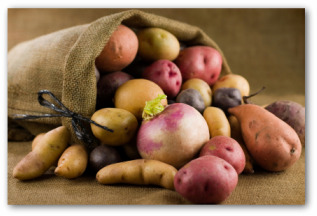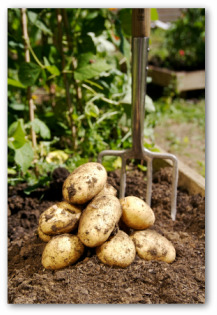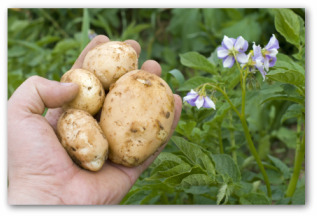Harvesting Potatoes, Storing Potatoes

Easy tips for harvesting potatoes from your vegetable garden. Learn how to harvest and store potatoes for best long-lasting results.
Design Your Own Vegetable Garden Layout Using our Free "Vegetable Garden Planner" Software!
Early potato types planted in April show the first signs of yellowing leaves in late June to indicate that the time for harvest of potatoes is near.
When all the leaves have yellowed and the foliage is withered and dry, wait 2-3 weeks before harvesting the potatoes. If you harvest too early, the potatoes will be small in size.
Harvesting New or Early Potatoes
However, it is possible to pick a small crop of delicious new potatoes before the plants are fully matured. Around two weeks after the potato blooms appear, you will discover new potatoes growing underground.
To harvest new tubers, push away the soil with your hands until the taters are found and simply pull them out of their garden bed.
New potatoes range from the size of a kumquat to lemon-sized, have a tender skin, and a sweet flavor.
While harvesting, if you accidentally scratch a potato's skin, be sure to harvest the spud. Left in the ground, the scratched area will develop into a rough scab.

Harvesting Potatoes
In August, 2-3 weeks after the foliage has died down entirely, the first of your early varieties of potatoes are ready for digging.
The first step in harvesting is to pull out the withered vines and put them in the compost pile. Tubers do not necessarily grow directly beneath the vines; instead they grow on underground stems, which may reach as far as ten inches out from the center of the row.
Download Free Garden Planning Worksheets, Garden Diary, Zone Chart, Or Planting Guide
-
To avoid inadvertently stabbing a tuber when harvesting, begin digging
about one foot out on either side of the center of the row using a 4
tined spading fork.
- Harvesting potatoes requires a light touch because any potato that is damaged during the digging process is likely to rot.
- Early potatoes are not as long lasting in storage as later varieties. Dig only enough for a few days use in the kitchen unless you want to use the potato row for another crop.
- After harvesting, leave the root vegetables sitting on top of the soil for several hours to allow them to dry thoroughly.
- Then put the produce in burlap or mesh bags and store in a cool, dark place. If the harvested potatoes are left in the light for even a few days, the skins will turn green.
Vegetable Gardening Tips for Harvesting Potatoes
Green potato skins are considered inedible.
If your potato crop is too near the surface and turning green several weeks before harvesting potatoes is scheduled, hill some soil up around the plants and add mulch or a thick layer of straw to cover the spuds.
After two or three weeks the green potato skins should turn brown and be ready for harvest on schedule. The hilling-up is standard practice in potato culture because it keeps the tubers deep underground where they are protected from the light. (I'm glad we don't turn green in the sunlight!)
September or October Potato Harvest
In September or October, it is time for harvesting the late maturing potato varieties picked for winter storage.
The potatoes are ready for digging several weeks after the tops of the plants have died away, leaving only dried, withered stalks.
By this stage, the tubers growing beneath the ground will have reached their maximum size.

Pick a dry, sunny day for harvesting potatoes.
Lift them from the ground as carefully as possible in making every effort to leave the spuds undamaged.
Unintentionally a few may be stabbed by the digging fork, so use them right away.
Lay the potatoes that come out unscathed on the ground to dry.
Storing Potatoes
After drying in a cool dark location such as a garage or shed for a few days to harden the skins, the potatoes can be washed if you want to do so.
They can also be stored unwashed.Store the crop in baskets or open mesh bags for the winter. Potatoes should be stored in a dark, dry, and cool location. The best storage temperature is 40 to 50 degrees. If they are not stored properly, they may shrivel, rot and/or begin to sprout.
Back To Top
Harvesting Potatoes to Vegetable Gardening
You Might Also like to Read:

